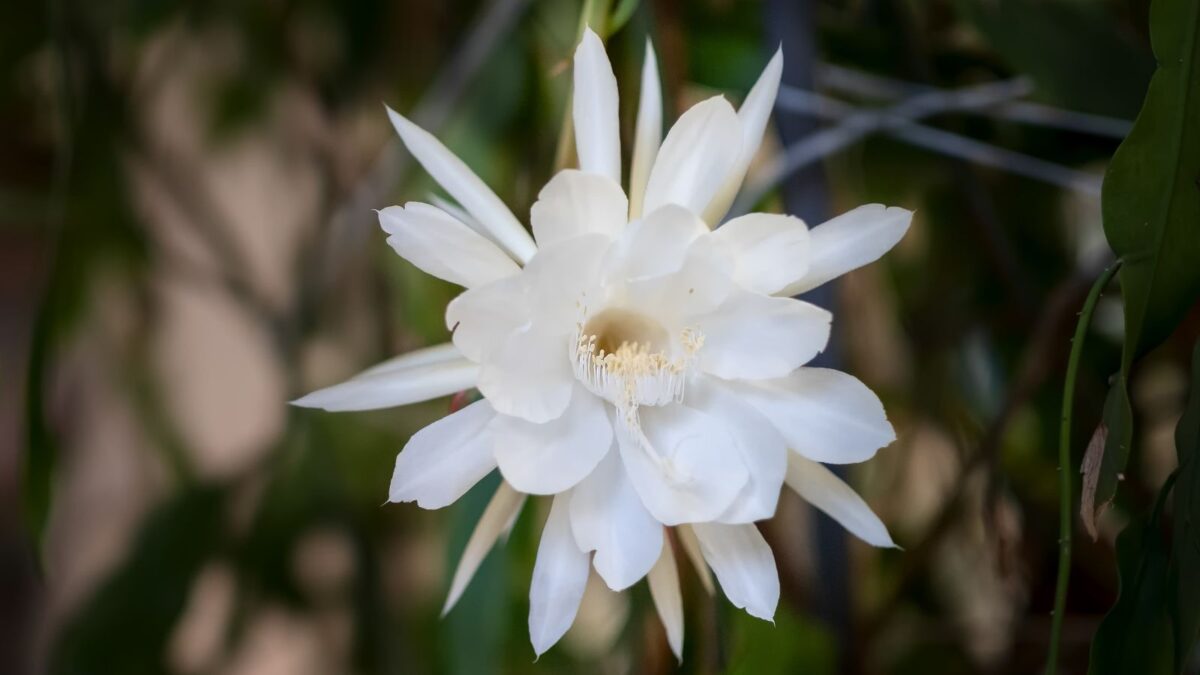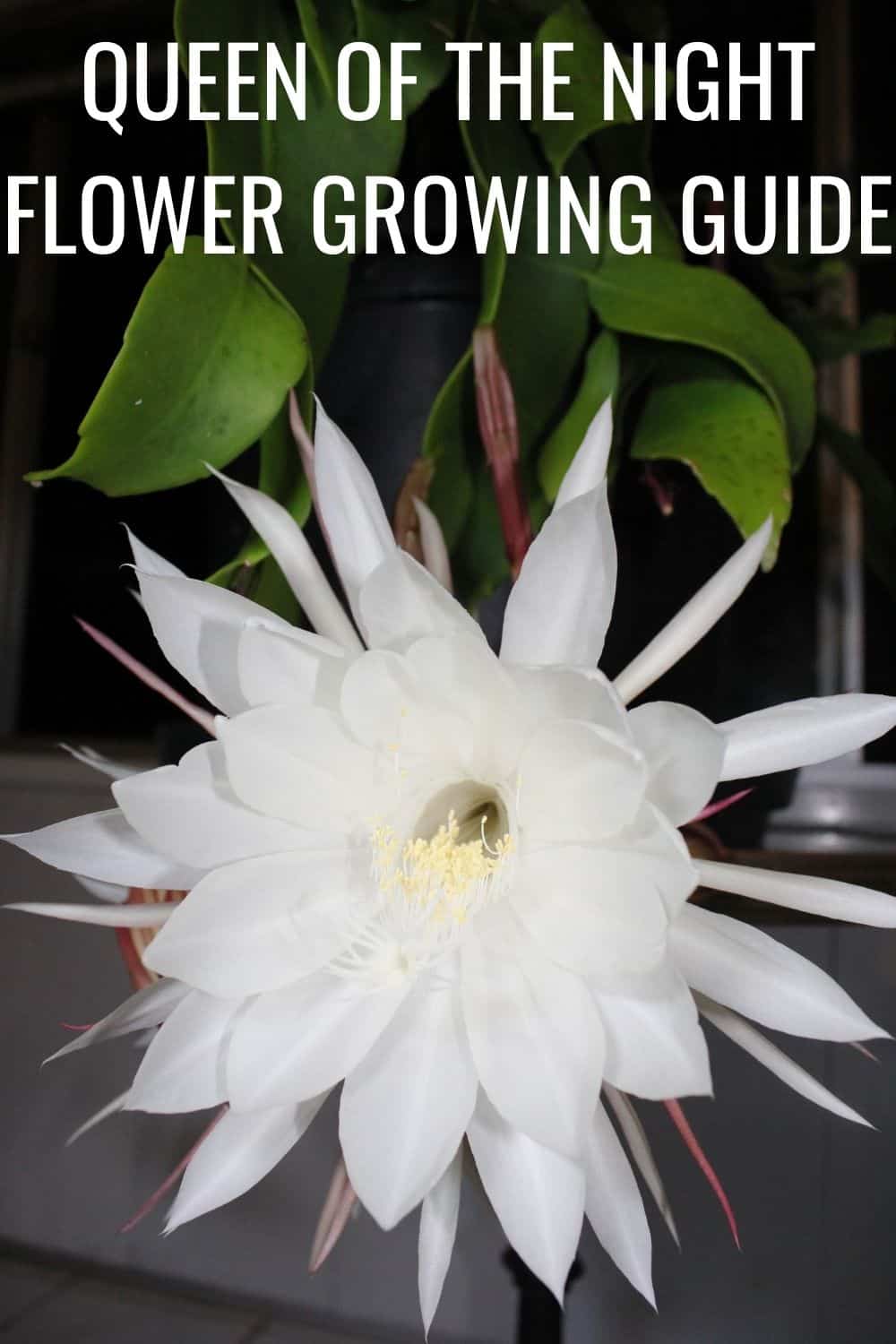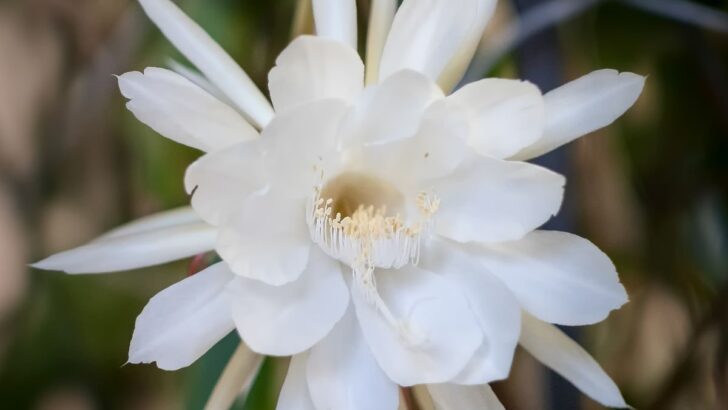People stay up at night to enjoy the opening of the flowers of the tropical wonder Epiphyllum petalum, better known by its common name, queen of the night flower, or orchid cactus, not to be confused with the night blooming cereus flower or the Dutchman’s pipe cactus. This astonishing cactus originates in Central America and South America and is prized around the world for its nine-inch wide large white flowers with an intoxicating scent that only appears after sundown and wither before the next morning.

In nature, the queen of the night cactus flower grows on trees. Not a parasite, it feeds on hummus made from dead insects, bat and bird droppings, and other decaying debris that accumulate in the notches between branches and the tree trunk.
The green growth of the plant is long and flat with spineless branches that are actually modified stems. These stems drape down, making them perfect for hanging with the right pot size. Queen of the night cactus flower likes dappled shade or full morning sun, but it does not do well in the hot afternoon sunshine.
All About Growing Queen Of The Night Flower
The mature size of queen of the night flower
Queen of the night flower plants will eventually form a lanky shrub about 6 feet (2 meters) across.
Cultivation of queen of the night flower
In nature, the queen of the night flower hangs down from trees. It is a great choice for hanging baskets. If you plant it at ground level, it needs to grow on a trellis or a shrub to prop it up.
Caring for queen of the night flower
How do you take care of a queen of the night plant?
Avoid planting queen of the night flower in full sun. Partial shade is best.
Morning sun increases the number of blooms you will get from your queen of the night flower all season. If your queen of the night plant is exposed to too much bright sunlight, especially too much bright afternoon sunlight, the stems will blanch from green to yellow. This doesn’t mean the plant is sick, it just needs less chlorophyll when it has more sun.
Some gardeners find that they get more flowers when their plants get both strong afternoon sunlight and relatively cool temperatures and don’t mind the yellow stems, since their plants bloom at night.
It is important to remember that the queen of the night flower is a cactus, so it is important not to overwater it. Let the top 3/4 of the potting mix dry out before drenching the plant from the top of the soil level down with warm water.
If you use tap water, let it stand for 24 hours before watering your queen of the night plant, so it will lose its chlorine. Pouring cold water into your queen of the night’s pot will cause the roots to harden so they do not absorb the next round of water and fertilizer.
If you grow this flower in a pot, you need to use a loose potting mix with coconut fiber or peat moss with lots of humus, but no sand and absolutely no dirt that you dig up from your backyard.
Feed your queen of the night flowers in the spring with fish emulsion or another high-nitrogen organic fertilizer. Avoid fertilizing them during their flowering season so you don’t get stem growth at the expense of flowers. Don’t disturb stems once they have attached themselves to latticework or other plants.
How to prune queen of the night flower
Remove dead or yellowing leaves with sterilized scissors or pruning shears. Cut off dead or dying parts of the plant at the nearest segment of healthy, green tissue.
Never cut through yellow tissue, since this can spread bacterial diseases.
Frost hardiness of the queen of the night cactus plant
If you have noticed queen of the night flowers on road trips, chances are that you were driving through the tropical zones of southern Mexico or extreme South Florida or, on the other side of the world, in home gardens in Queensland or the shoreline of Northern Territory in Australia.
Gardeners should not try to keep this plant outdoors year-round in any climate cooler than USDA Hardiness Zone 11: all other hardiness zones would need to bring it indoors in the winter months.
You should also grow it indoors only if your summer temperatures fall below 50° F (10° C) at night.
Queen of the night flower is damaged by even brief exposure to temperatures below 40° F (4° C). Move it to a sunny window indoors if you need to keep it over the winter.
Repotting queen of the night
Queen of the night plants can outgrow their pots about every two years. Forty-eight hours before repotting your orchid cactus plant, collect about a quart (a liter) of tap water and let it stand uncovered for the chlorine to dissipate.
Twenty-four hours before repotting, give it a thorough soaking with the warm tap water. The next day, transfer it to a larger pot, using coconut fiber and peat or, even better, cactus & succulent plant potting mix.
Propagating tips
Make new plants by stem or leaf cuttings.
Cut off a growing stem of a healthy plant and let it dry out for four or five days in a cool, dry place. Then place the cut end of the stem in a small pot of well-drained potting soil.
Or simply cut off leaves and press them into small pots of moist potting soil. (This method requires more moisture than growing queen of the night flower from stem cutting).
Either way, it can take a long time to get a new queen of the night flower plant this way, although these vegetative propagation methods are a way to clone plants with exceptional colors that you can’t find in nurseries. (Growing them from seed takes longer.)
Keep your queen of the night flower dry during cool weather and give it more water during the summer. Fertilize only during the growing season until the plant begins to bloom.
Queen of the night flower varieties
There are several species of queen of the night flower, including one that has blooms that last until about 10 o’clock in the morning.
Epiphyllum oxypetalum is the shorter species of the plant, with flowers in bright white colors and also in fire engine red or hot pink varieties available in nurseries.
The red queen of the night flowers make a spectacular end of the year display when they are grown in warm climates.
Epiphyllum stricta doesn’t climb trees like Epiphyllum can, but it drapes down 4 or 5 feet and has blooms that last until late morning. This species of queen of the night cactus blooms later in the season than Epiphyllum oxypetalum, well into the fall.
Frequently asked questions
How can I recognize common plant problems in my queen of the night flower?
Yellow leaves, mushy roots, and collapsing stems are usually caused by overwatering. Giving your plant too much water can also cause its base to turn brown. Sprinkling water over the leaves instead of watering just the soil, not the plant, can result in loss of leaves at the center of the plant.
Too much sunlight can cause leaves to turn red. Not giving your plant a winter rest period can reduce flowering the next year.
Queen of the night plants are also vulnerable to scale, mealy bugs, and bacterial leaf spot.
Isn’t the queen of the night flower a form of lotus?
No, although the queen of the night flower is sometimes referred to as the night lotus in Hindu culture, or gulebakavali in the ancient Tamil language.
How often does queen of the night flower bloom?
You can expect queen of the night flower blooms throughout their growing season, but each bloom only lasts one night.
What does queen of the night flower symbolize?
Queen of the night flower is used as a metaphor for ephemeral beauty. Its spectacular, fragrant blooms can be enjoyed for a few hours, and then they disappear.
Should I let my queen of the night flowers in pots completely dry out between waterings?
Even though this is a succulent plant, it needs more water than most other cacti and succulents. Give them water about once a week, but don’t let water stand on the leaves, to avoid fungal leaf spot disease.
Are queen of the night flower and dragon flower the same?
No, the dragon flower that produces dragon fruit, also known as pitaya, is a different plant. Dragon flowers don’t have to be grown in extremely loose soil, and they are more likely to be found growing in rows in a ground-level planting, than hanging down from baskets or growing in trees.
Also, dragon flowers bloom in the morning and fade by the evening. However, both the queen of the night flower and the dragon flower are cacti.
What does queen of the night flower smell like?
The scent of this cactus flower is usually described as warm, floral, and sweet. But the most memorable characteristic of the queen of the night flower’s scent is that it is strong. This flower has to be pollinated by bats, birds, or bugs the same night that it opens. To ensure pollination, the flower produces a strong aroma that can be smelled as much as one-quarter of a mile away.
Is queen of the night plant poisonous?
Queen of the night flowers aren’t poisonous, although eating a large amount of them (over an ounce, or about 30 grams) would probably induce vomiting. This plant is non-toxic to dogs, although other night-blooming flowers are.
How do you know when queen of the night flower will bloom?
Queen of the night puts out flowering buds that curl upward a day or two before they open into flowers. Once you see the upward curl, check your plant every night.
How do I make queen of the night bloom?
You can encourage blooming by giving your plant less water at the beginning of its blooming season (but without letting it get completely dry).
Why does the queen of the night plant only bloom at night?
Queen of the night flowers depend on bats, birds, and bugs for pollination, not bees. The huge flowers of the plant are too deep for bees to pollinate.
More Fragrant Flowers
If you like fragrant flowers, look at my list below for inspiration.
- 12 Fragrant Annual Flowers
- The Most Fragrant Roses To Plant In Your Garden
- 11 Fragrant Perennial Flowers For The Perfect Scented Garden
- 7 Scented Garden Ideas That Engage The Senses
- How to Grow Lavender Guide




Joan
Friday 15th of July 2022
Mine is blooming and fragrant right now!!!